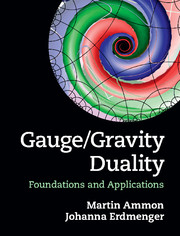Book contents
- Frontmatter
- Contents
- Preface
- Acknowledgements
- Part I Prerequisites
- Part II Gauge/Gravity Duality
- Part III Applications
- 12 Linear response and hydrodynamics
- 13 QCD and holography: confinement and chiral symmetry breaking
- 14 QCD and holography: finite temperature and density
- 15 Strongly coupled condensed matter systems
- Appendix A Grassmann numbers
- Appendix B Lie algebras and superalgebras
- Appendix C Conventions
- Index
- References
15 - Strongly coupled condensed matter systems
from Part III - Applications
Published online by Cambridge University Press: 05 May 2015
- Frontmatter
- Contents
- Preface
- Acknowledgements
- Part I Prerequisites
- Part II Gauge/Gravity Duality
- Part III Applications
- 12 Linear response and hydrodynamics
- 13 QCD and holography: confinement and chiral symmetry breaking
- 14 QCD and holography: finite temperature and density
- 15 Strongly coupled condensed matter systems
- Appendix A Grassmann numbers
- Appendix B Lie algebras and superalgebras
- Appendix C Conventions
- Index
- References
Summary
Within condensed matter physics, there are many extremely interesting physical systems which are strongly coupled. Although various approaches have been developed within condensed matter physics to deal with strongly coupled systems, there are many important physically relevant examples where a description in terms of theoretical models has not been successful. It thus appears natural to make use of gauge/gravity duality, which is very effective for describing systems at strong coupling, in this context as well. Of course, the microscopic degrees of freedom in a condensed matter system are very different from those described by a non-Abelian gauge theory at large N. For instance, these systems are non-relativistic in general. Nevertheless, the idea is to make use of universality again and to consider systems at second order phase transitions or renormalisation group fixed points, where the microscopic details may not be important. A prototype example of this scenario is given by quantum phase transitions, i.e. phase transitions at zero temperature which are induced by quantum rather than thermal fluctuations. These transitions appear generically when varying a parameter or coupling, which does not have to be small, such that the use of perturbative methods may not be possible.
In many cases, the study of models relevant to condensed matter physics involves the introduction of a finite charge density in addition to finite temperature. This applies for instance to Fermi surfaces or condensation processes. In the gauge/gravity duality context, this is obtained in a natural way by considering charged black holes of Reissner–Nordström type. Their gravity action involves additional gauge fields. Within this approach, standard thermodynamical quantities such as the free energy and the entropy may be calculated. A further important observable characterising the properties of condensed matter systems is the frequency-dependent conductivity. This is calculated in a straightforward way using gauge/gravity duality techniques.
A very instructive example of a quantum phase transition within gauge/gravity duality is obtained by using a magnetic field as the control parameter.
- Type
- Chapter
- Information
- Gauge/Gravity DualityFoundations and Applications, pp. 460 - 504Publisher: Cambridge University PressPrint publication year: 2015

